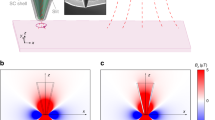Abstract
Integrated magnetic sensors based on niobium dc SQUID (Superconducting Quantum Interference Device) for nanoparticle characterizations are presented. The SQUIDs consists of two Dayem bridges of 90 nm × 250 nm and loop area of 4, 1, and 0.55 μm2. The devices are realized by using an e-beam lithography nano-fabrication process which can directly pattern the devices in an electron-positive resist and then transferred to a 20 nm single niobium layer by a lift-off post-process. The SQUIDs were designed to have a hysteretic current–voltage characteristic in order to work as a magnetic flux-current transducer. The presence of an integrated niobium coil, tightly coupled to the SQUID, allows us to easily excite the SQUID and to flux bias the SQUID at its optimal working point. Current–voltage characteristics, critical current as a function of the external magnetic field and switching current distributions were performed at liquid helium temperature. A critical current modulation of about 20% and a current-magnetic flux transfer coefficient (responsivity) of 30 μA/Φ0 have been obtained, resulting in a magnetic flux resolution better than 1 mΦ0. The authors performed preliminary measurements with and without iron oxide nanoparticles on the SQUID loop in order to show the device sensitivity in view of nano-magnetism applications. It was showed that the presence of magnetic nanoparticles can be easily detected and the magnetic relaxation curve measured.





Similar content being viewed by others
References
Bouchiat V (2009) Detection of magnetic moments using a nano-SQUID: limits of resolution and sensitivity in near-field SQUID magnetometry. Supercond Sci Technol 22:064002
Clarke J, Braginski AI (eds) (2006) The SQUID handbook: fundamentals and technology of SQUIDs and SQUID systems, vol 2. Wiley-VCH Verlag GmbH & Co. KgaA, Weinheim, p 251
Cleuziou JP et al (2006) Carbon nanotube superconducting quantum interference device. Nature Nanotech 1:53–59
Faucher M, Jubert PO, Fruchart O, Wernsdorfer W, Bouchiat V (2009) Optimizing the flux coupling between a nanoSQUID and a magnetic particle using atomic force microscope nanolithography. Supercond Sci Technol 22:064010
Finkler A et al (2010) Self-aligned nanoscale SQUID on a tip. Nanoletters 10:1046–1049
Granata C et al (2008) An integrated superconductive magnetic nanosensor for high-sensitivity nanoscale applications. Nanotechnology 19:275501–275506
Granata C, Vettoliere A, Walke P, Nappi C, Russo M (2009) Performance of nano superconducting quantum interference devices for small spin cluster detection. J Appl Phys 106:023925. doi:10.1063/1.3183959
Hao L et al (2008) Measurement and noise performance of nano-superconducting-quantum interference devices fabricated by focused ion beam. Appl Phys Lett 92:192507–192509
Jamet M, Wernsdorfer W, Thirion C, Mailly D, Dupuis V, Me′linon P, Pe′rez A (2001) Magnetic anisotropy of a single cobalt nanocluster. Phys Rev Lett 86:4676–4679
Josephs-Franks P, Hao L, Tzalenchuk A, Davies J, Kazakova O, Gallop JC, Brown L, Macfarlane JC (2003) Measurement of the spatial sensitivity of miniature SQUIDs using magnetic-tipped STM. Supercond Sci Technol 16:1570–1574
Lam SKH, Gnanarajan Sabaratnasingam (2009) Hysteretic behaviour of nanoSQUIDs—prospective application as trapped-vortex memory. Supercond Sci Technol 22:064005
Lam SKH, Tilbrook DL (2003) Development of a niobium nanosuperconducting quantum interference device for the detection of small spin populations. Appl Phys Lett 82:1078–1080
Lam SKH, Yang W, Wiogo HTR, Foley CP (2008) Attachment of magnetic molecules on a nanoSQUID. Nanotechnology 19:285303
Podd GJ, Hutchinson GD, Williams DA, Hasko DG (2007) Micro-SQUIDs with controllable asymmetry via hot-phonon controlled junctions. Phys Rev B 75:134501
Tettamanzi GC, Pakes CI, Lam SKH, Prawer S (2009) Flux noise in ion-implanted nanoSQUIDs. Supercond Sci Technol 22:064006
Tilbrook DL (2009) NanoSQUID sensitivity for isolated dipoles and small spin populations. Supercond Sci Technol 22:064003. doi:10.1088/0953-2048/22/6/064003
Troeman AGP, Derking H, Borger B, Pleikies J, Veldhuis D, Hilgenkamp H (2007) NanoSQUIDs based on niobium constrictions. Nano lett 7:2152–2156. doi:10.1021/nl070870f
Vohralik PF, Lam SKH (2009) NanoSQUID detection of magnetization from ferritin nanoparticles. Supercond Sci Technol 22:064007. doi:10.1088/0953-2048/22/6/064007
Volkov I, Chukharin M, Snigirev O et al (2008) Determination of the anisotropy constant and saturation magnetization of magnetic nanoparticles from magnetization relaxation curves. J Nanopart Res 10:487–497. doi:10.1007/s11051-007-9282-y
Wernsdorfer W (2009) From micro-to nano-SQUIDs: applications to nanomagnetism. Supercond Sci Technol 22:064013. doi:10.1088/0953-2048/22/6/064013
Wernsdorfer W, Doudin B, Mailly D, Hasselbach K, Benoit A, Meier J, Ansermet J-Ph, Barbara B (1996) Nucleation of the magnetization reversal in individual nanosized nickel wires. Phys Rev Lett 77:1873
Wernsdorfer W, Bonet Orozco E, Hasselbach K, Benoit A, Barbara B, Demoncy N, Loiseau A, Boivin D, Pascard H, Mailly D (1997a) Experimental evidence of the n′eel–brownmodel of magnetization reversal. Phys Rev Lett 78:1791
Wernsdorfer W, Bonet Orozco E, Hasselbach K, Benoit A, Mailly D, Kubo O, Nakano H, Barbara B (1997b) Macroscopic quantum tunneling of magnetization of single ferrimagnetic nanoparticles of barium ferrite. Phys Rev Lett 79:4014
Wernsdorfer W, Mailly D, Benoit A (2000) Single nanoparticle measurement techniques. J Appl Phys 87:5094. doi:10.1063/1.373259
Acknowledgments
The authors are grateful to D. Fiorani for stimulating discussions and L. Suber for providing us the iron oxide nanoparticles. The authors also would like to thanks B. Ruggiero for helpful discussions about switching current distribution measurements.
Author information
Authors and Affiliations
Corresponding author
Rights and permissions
About this article
Cite this article
Russo, R., Granata, C., Walke, P. et al. NanoSQUID as magnetic sensor for magnetic nanoparticles characterization. J Nanopart Res 13, 5661–5668 (2011). https://doi.org/10.1007/s11051-011-0330-2
Received:
Accepted:
Published:
Issue Date:
DOI: https://doi.org/10.1007/s11051-011-0330-2




